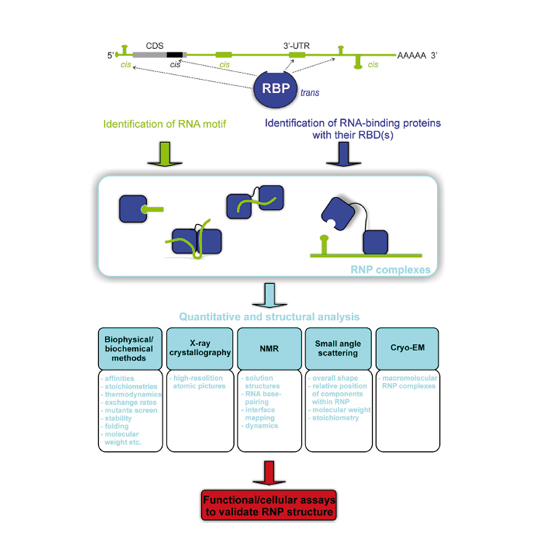Integrated structural biology to unravel molecular mechanisms of protein-RNA recognition
16-Mar-2017
Methods, Volumes 118–119, Pages 119-136, https://doi.org/10.1016/j.ymeth.2017.03.015
Methods, online article
Recent advances in RNA sequencing technologies have greatly expanded our knowledge of the RNA landscape in cells, often with spatiotemporal resolution. These techniques identified many new (often non-coding) RNA molecules. Large-scale studies have also discovered novel RNA binding proteins (RBPs), which exhibit single or multiple RNA binding domains (RBDs) for recognition of specific sequence or structured motifs in RNA. Starting from these large-scale approaches it is crucial to unravel the molecular principles of protein-RNA recognition in ribonucleoprotein complexes (RNPs) to understand the underlying mechanisms of gene regulation. Structural biology and biophysical studies at highest possible resolution are key to elucidate molecular mechanisms of RNA recognition by RBPs and how conformational dynamics, weak interactions and cooperative binding contribute to the formation of specific, context-dependent RNPs. While large compact RNPs can be well studied by X-ray crystallography and cryo-EM, analysis of dynamics and weak interaction necessitates the use of solution methods to capture these properties.
Here, we illustrate methods to study the structure and conformational dynamics of protein-RNA complexes in solution starting from the identification of interaction partners in a given RNP. Biophysical and biochemical techniques support the characterization of a protein-RNA complex and identify regions relevant in structural analysis. Nuclear magnetic resonance (NMR) is a powerful tool to gain information on folding, stability and dynamics of RNAs and characterize RNPs in solution. It provides crucial information that is complementary to the static pictures derived from other techniques. NMR can be readily combined with other solution techniques, such as small angle X-ray and/or neutron scattering (SAXS/SANS), electron paramagnetic resonance (EPR), and Förster resonance energy transfer (FRET), which provide information about overall shapes, internal domain arrangements and dynamics. Principles of protein-RNA recognition and current approaches are reviewed and illustrated with recent studies.











